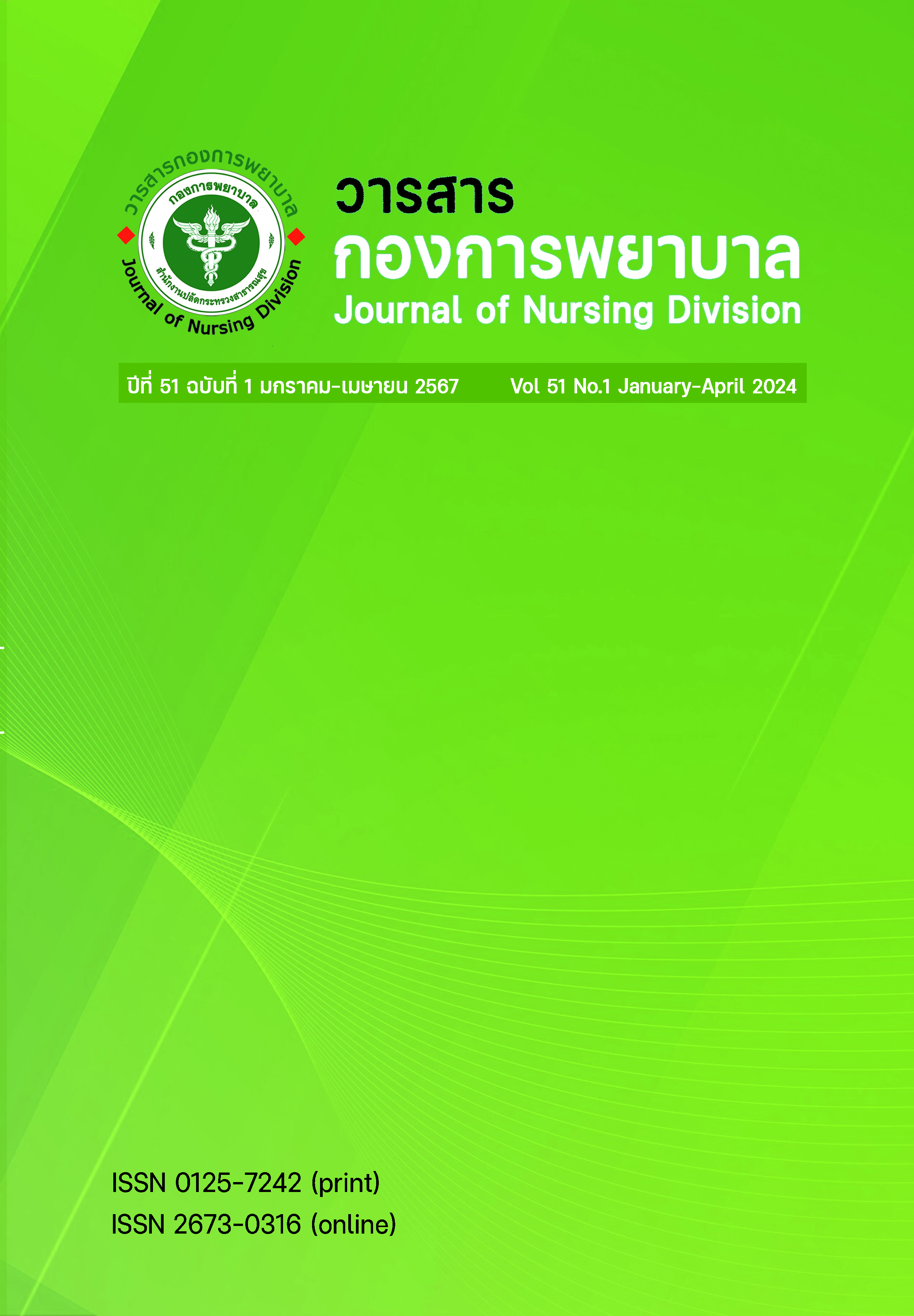การพัฒนารูปแบบการพยาบาลผู้ป่วยใช้เครื่องช่วยหายใจ กลุ่มงานอายุรกรรม โรงพยาบาลเลย
Main Article Content
บทคัดย่อ
บทคัดย่อ
การวิจัยและพัฒนานี้ มีวัตถุประสงค์เพื่อพัฒนาและศึกษาผลลัพธ์ของรูปแบบการพยาบาลผู้ป่วยใช้เครื่องช่วยหายใจ กลุ่มตัวอย่างคัดเลือกแบบเจาะจง คือ (1) หัวหน้าหอผู้ป่วยและพยาบาลวิชาชีพ 24 คน และ (2) ผู้ป่วยใช้เครื่องช่วยหายใจ 60 คน ดำเนินการ 3 ระยะ (1) วิเคราะห์สถานการณ์ (2) พัฒนารูปแบบ และ (3) ประเมินผลลัพธ์ เครื่องมือวิจัย ประกอบด้วย (1) แบบบันทึกข้อมูลทั่วไปของพยาบาล (2) แบบบันทึกข้อมูลทั่วไปของผู้ป่วย (3) แบบประเมินสมรรถนะพยาบาลในการพยาบาลผู้ป่วยใช้เครื่องช่วยหายใจ (4) แนวปฏิบัติการพยาบาลผู้ป่วยใช้เครื่องช่วยหายใจ (5) แบบติดตามการปฏิบัติและผลลัพธ์ (6) แบบสอบถามความสามารถในการปฏิบัติของพยาบาล (7) แบบสอบถามความพึงพอใจของพยาบาลต่อรูปแบบฯ (8) แบบสังเกตแบบมีส่วนร่วม (9) แนวคำถามการประชุมกลุ่มแบบ focus group และ (10) แนวคำถามการสัมภาษณ์เชิงลึก ตรวจสอบความเชื่อมั่นของเครื่องมือโดยผู้ทรงคุณวุฒิ 5 คน ครอนบาคอัลฟาของเครื่องมือลำดับที่ (3), (5), (7) มีค่าเท่ากับ .80, .70, และ.74 ตามลำดับ วิเคราะห์ข้อมูลเชิงปริมาณด้วยร้อยละ และค่าเฉลี่ย ข้อมูลเชิงคุณภาพใช้การวิเคราะห์เนื้อหา
ผลการวิจัย พบว่า รูปแบบการพยาบาลผู้ป่วยใช้เครื่องช่วยหายใจ ประกอบด้วย (1) แนวปฏิบัติการพยาบาลผู้ป่วยใช้เครื่องช่วยหายใจ (2) การพัฒนาสมรรถนะพยาบาล (3) คู่มือการใช้กระบวนการพยาบาลผู้ป่วยใช้เครื่องช่วยหายใจ และ (4) แผนการนิเทศทางการพยาบาล ผลลัพธ์ด้านพยาบาล พบว่า หลังใช้รูปแบบฯ พยาบาลมีสมรรถนะการพยาบาลผู้ป่วยใช้เครื่องช่วยหายใจสูงกว่าก่อนใช้รูปแบบอย่างมีนัยสำคัญทางสถิติ (p = .001) ร้อยละ 95.8 มีความพึงพอใจในภาพรวมต่อรูปแบบฯ อยู่ในระดับมาก และมีความสามารถในการใชแนวปฏิบัติ ผลลัพธ์ด้านผู้ป่วย พบว่า อัตราการเลื่อนหลุดของท่อช่วยหายใจลดลงจาก 9.5 เป็น 0.0 อัตราการเกิดปอดอักเสบที่สัมพันธ์กับการใช้เครื่องช่วยหายใจลดลงจาก 8.3 เป็น 0.0 ต่อ 1,000 วันใช้เครื่องช่วยหายใจ ระยะเวลาเฉลี่ยที่ใช้เครื่องช่วยหายใจลดลงจาก 3.4 เป็น 2.8 วัน และวันนอนเฉลี่ยในหอผู้ป่วยลดลงจาก 6.7 เป็น 4.9 วันอย่างมีนัยสำคัญที่ .001
Article Details

อนุญาตภายใต้เงื่อนไข Creative Commons Attribution-NonCommercial-NoDerivatives 4.0 International License.
เอกสารอ้างอิง
References
Kunjana Pukkham. Development a Cring Model of Critical ill Surgical Patients with Difficult Weaning UsingABCDEF- R Bundle. Thai Journal of Nursing and Midwifery Practice.2022; 1(9): 50-70. Thai.
Sricharoenchai Thiti. Ventilator for beginners: When to start invasive ventilation and what to give?. In: Dusit Sataworn, KronchitPiyawetwirat, editor. Nonthaburi: Beyond Enterprise Co., Ltd.; 2016. Thai.
Dar M, Swamy L, Gavin D, TheodoreA.Mechanic ventilation supply and options for the COVID- 19 pandemic. Leveraging all available resource for a limited resource in a crisis. Annals of the American Thoracic Society. 2021; 18(3):408-416.
Kaweesak Chittawatanarat, Thananchai Bunburaphong, Ratapum Champunot. Mechanical Ventilators Availability Survey in Thai ICUs (ICU- RESOURCE I Study). J Med ASSOC Thai. 2014;1(97): S1- S7. Thai.
Lim KP, Kuo SW, Ko WJ, Sheng WH, Chang YY, Hong MC, et al. Efficacy of ventilator associated pneumonia care bundle for prevention of ventilator- associated pneumonia in the surgical intensive care units of a medical center. Journal of Microbiology Immunology and Infection. 2015;48(3):132-136.
Chu YF, Jiang Y, Meng M, Jiang JJ, Zhang JC, Ren HS, et al, Incidence and risk factors of gastrointestinal bleeding in mechanically ventilated patients. World J Emerg Med.2010;1(1):32-36.
Tonnelier A, Tonnelier JM, Nowak E, Gut GC, Prat G, Renault A, et al. Clinical relevance of classification according to weaning difficulty. Respir Care. 2011;56(5):583-90.
Kunjana Pukkham, Kusuma Khuwatsamrit, Tarntip Wisettharn. Evaluating the feasibility and Clinical Outcome for Assessment Prevention and Management of Acute Delirium in a Surgical Intensive Care Unit. Thai Journal of Nursing and Midwifery Practice. 2019;6(1):68-86. Thai.
Chantira Chiarania, Artinuch Benjarak, Kanoknat Kingsanthia, Surangkhana Prommart. Nursing Care of Critical Patients with Mechanical Ventilation: Self- care Theory and the Application of Nursing Systems Theory. Journal of Health and Nursing Education. 2022;28(1):1-12. Thai
Loei Hospital information. 2565;[Online database]
Chanphen Niamwan. Principles of medical equipment maintenance. In: Yongyut Kajonpreedanon, editor. Equipment Medicine in the intensive care unit. 8th printing. Bangkok: STC Media and Marketing Co., Ltd.; 2014. Thai
Rosswurm MA, Larrabee JH. A Model for change to Evidence- Based Practice. Journal of Nursing Scholarship. 1999;13(4): 317- 322.
Creswell J W, Clark VLP. Designing and conducting mixed methods research. (2nd ed.) SAGE publishing. 2011.
Faul F, Erdfelder E, Lang A-G, Buchner A. G*Power 3: A flexible statistical power analysis program for the social, behavioral, and biomedical sciences. Behavior Research Methods 2007; 39(2):175-191. Available from: https://doi.org/10.3758/BF03193146
Joanna Briggs Institute. The JBI Levels of evidence. [Internet]. 2014 [cited 2022 Mar 4]; [5 screens]. Available from: URL: https://ospguides.ovid.com/OSPguides/jbidb.htm of practice. Nurs Clin North Am.2000;39(4):301-9.
NANDA. International and T. Heather Herdman. NANDA International Nursing Diagnosis: Definitions and Classification 2021-14. Wiley-Blackwell,2012.
Proctor B. Training for the supervision alliance attitude, skill and intention in Fundamental themes in clinical supervision. London: Routledge; 2001.
Colaizzi PF. Psychological research as the phenomenologist views it. In R. Vale & M.King (Eds.), Existential-phenomenological alternatives for psychology. New York: Oxford University Press,1978; 48-71.
Yaowalux Mentaganuwong, Kloychai Sanwong. Develop of Nursing Management Model for Receiving and Referral of Myocardial ischemia. Patients at Yasothon. Journal of Nursing Division. 2022;49(3):1-15. Thai
Laddawan Thongkleang Effect of development the professional nurse 4.0 era’s competency in caring patients use volume ventilator in Medical intensive Care Unit, Suratthani Hospital. Journal of Health Research. 2021;4(2):54-64. Thai


